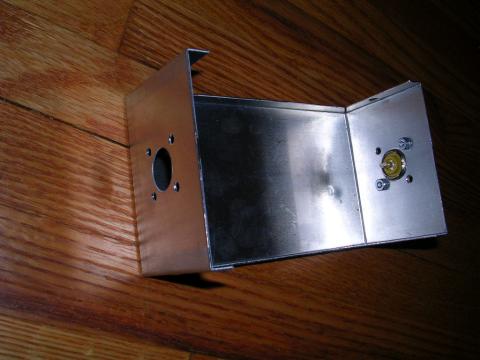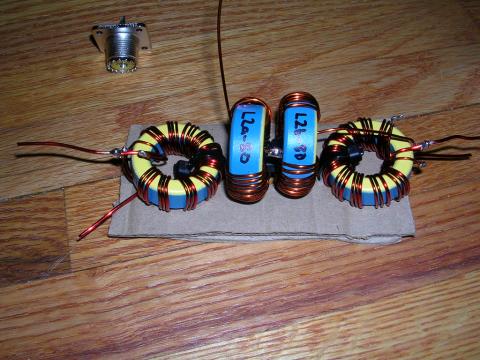Introduction
Given that the most popular search hit for k8gu.com is “w3nqn”, I thought I’d share a little bit about my experiences building the W3NQN bandpass filters. This is updated from an old version of the site and will continue to receive updates. So, please check the date and review it carefully. I also wrote a relevant article for the March/April 2008 issue of NCJ, although this article has several errors, including some introduced by the production staff.

This photograph shows my original W3NQN filter installation at K8GU/9. I had the radios configured in what I call the “K8GL-configuration” so that each radio had its band: 160-40-15 on one and 80-20-10 on the other. Not only does this simplify switching, it provides excellent isolation. See my K8GU/3 station description for details on how I have them connected presently.
Motivation
So, you’ve reached the point in your contesting career that you can hold a run frequency but find yourself getting bored between callers and antsy about missing multipliers. Enter SO2R, single-operator, two-radios. (If you’re new to this concept, there are plenty of other resources on the web. Essentially, you tune around looking for contacts with one radio while CQing on the other.)
I live on a typical urban lot. Thus, I don’t have room to get good antenna separation to help me protect my radios (and ears) from each other. In fact, at K8GU/9, my first two antennas passed within inches. When I transmited at 100 watts on the 80-meter antenna, I had about 2.5 watts coming back down the 40-meter antenna. I can’t imagine that would be good for my receiver, even after preselection.
Some sort of bandpass filter is in order. Of course, I was well-aware of the W3NQN filters from conversations with other contesters and reading about their stations. I also had the good fortune to be able to compare the competing commercial ICE and Dunestar filters on a network analyzer. (Note that the axes labeled IL and RL are actually |S21| and |S11|, respectively, a novice mistake. I will fix this eventually. If you have no idea what I’m talking about don’t worry.) Based on those measurements and those provided in the W3NQN articles, plus some measurements on a preliminary W3NQN 160-meter filter I built, I decided that the W3NQN filters were indeed the ones to have. Of course, you pay for quality. Array Solutions carries the W3NQN filters for $95 per band. In true ham spirit, I reasoned that I could build them myself for far less.
Before I go on, I need to mention something very important that W3LPL rightly likes to emphasize when the discussions of comparing filters arise. Network analyzer plots do not tell the entire story in an amateur station. A network analyzer takes great pains to calibrate its measurements to 50-ohm (or 75, if you configure it) source and load impedances at all measurement frequencies. Real transmitters, amplifiers, and antennas, do not present constant resistive impedances everywhere. The proper way to analyze such a system is to make 2-port (1-port for antennas and transmitters) measurements of all components (referred to 50 ohms or whatever) and assemble them in cascade. Or, an even easier test that I use in my own station is described below
Component Selection
The amount of engineering and design that W3NQN put into his filters is staggering. His articles are thorough and methodical. Along with that comes the very precise selection of components. Unfortunately, the high-voltage capacitors are not readily-available through the usual distribution channels available to amateurs.
When I originally started working on these filters in 2004, the T130-17 cores were difficult to obtain in small quantities. I was able to successfully obtain samples of the T130-17 cores from Micrometals. I actually tried to purchase them; but, it is apparently cheaper for them to give away a few samples than process and fill a small order. Diz, W8DIZ, has stepped into the void and now offers a complete kit of the cores required to build a set of six filters for the MF/HF contest bands.
The Tusonix capacitors proved more difficult. I was able to obtain some literature from them, although the exact parts used by Wetherhold are no longer listed and I was unable to obtain pricing information. So, I ran to my stack of electronic parts catalogs (obtained free from work and much easier to use for component selection than the web). Digi-Key carries Panasonic high-voltage capacitors that are reasonably-priced. Unfortunately, the Panasonic capacitors are not NP0/C0G nor do they come in the same values as the Tusonix capacitors. However, I’ve not yet noticed any ill effects from not having NP0, although I’m sure there is some temperature rise during operation. Did you know that Digi-Key was founded and is still owned by a ham? N5IN. That’s your trivia reward for reading this far.
I’ve had considerable interaction with several hams regarding the choice of the capacitors, notably Ford, N0FP, Rich, AJ3G, and John, W0UN. Ford used silver mica capacitors throughout since he had a ready supply of them with high voltage ratings. Rich used a variety of NP0 capacitors that he was able to find through Newark and eBay. John encouraged me to actually measure the temperature rise in the filters (something I still have not done since they’ve been doing the job for me) before settling for non-NP0 capacitors. So, these are some other options and considerations. I’m 99% sure that at least one commercial implementation uses the same Panasonic capacitors that I use. Although, I’ve heard privately that W3NQN was not pleased with the quality of that product and that his callsign was associated with it. Perhaps I should call my variants the W3NQN/K8GU filters so someone else shares the blame in this case!
The connectors, magnet wire, and enclosures are all readily available. The total components cost, not including excess parts and mistakes, for one filter breaks down as follows: $6 capacitors, $15 cores, $4 mini-box, $6 connectors, $3 wire, for a total of $34/filter. With some scrounging or quantity purchasing, you can do it for less.
Construction
There’s not too much to talk about here. I built the filters. If you don’t have one, you should buy a 5/8″ knock-out punch to make the holes for the connectors. Mine was made by Greenlee and I bought it from McMaster-Carr. It’s far better than anything else. I used 1/4″ long 4-40 screws to attach the connectors to the box. At the advice of K4OJ posted to the TowerTalk reflector several years ago, I use Amphenol connectors in all my new projects. Life is too short for cheap connectors or cheap coax.

One of the questions I am most frequently asked is how to wind the multifilar toroid cores. I have a sketch somewhere that I will post soon. If I recall correctly, the secondary winding can be one continuous piece that circuits the core several times, although I did not think to wind it that way until after winding most of mine.
I built the filters on a corrugated cardboard “breadboard” that serves to raise them above the bottom of the mini-box. I figured if cardboard was good enough for W3NQN, it was good enough for me. Although, I would like to replace it with something a little more “professional”, nobody will see it unless it catches fire.

Here’s what the finished product looks like inside.

Measurement
When I was at University of Minnesota, I had 24/7 access to three HP vector network analyzers covering 30 kHz-50 GHz and later at the University of Illinois, I had sporadic access. But, no longer. If my capital equipment request ever gets approved, this situation will be rectified—and I honestly need it for work, not just measuring filters and amplifiers.
My preliminary measurements (using insertion loss measurements with an oscilloscope and a dummy load) estimate approximately 45 dB attenuation of the 80-meter fundamental with the 40-meter installed. This measurement was performed by transmitting on the 80-meter antenna with the 40-meter antenna terminated in a dummy load. An oscilloscope was used to measure the voltage (peak-to-peak or RMS, doesn’t matter in this case) across the resistor. The same measurement was performed with the filter between the antenna and the dummy load. The insertion loss at the fundamental is estimated using the following equation:
IL = -20 log10 (Vfilter/Vnofilter)
Conclusion
If you are willing to make some component substitutions, the W3NQN filters are an excellent, economical, bandpass filter solution. They do take a while to build. Give yourself at least two-three hours per filter. I believe that my experience indicates that expensive test gear isn’t necessary to build the filters. Although, access to a Network Analyzer is certainly beneficial if you’d like to know what’s really going on inside.
References
Both of these articles used to be available through the ARRL TIS web site. You did not have to be an ARRL Member to access them. I couldn’t find them when I just looked.
- Wetherhold, “Clean up your signal with band-pass filters–Part I,” QST May 1998.
- Wetherhold, “Clean up your signal with band-pass filters–Part II,” QST June 1998.